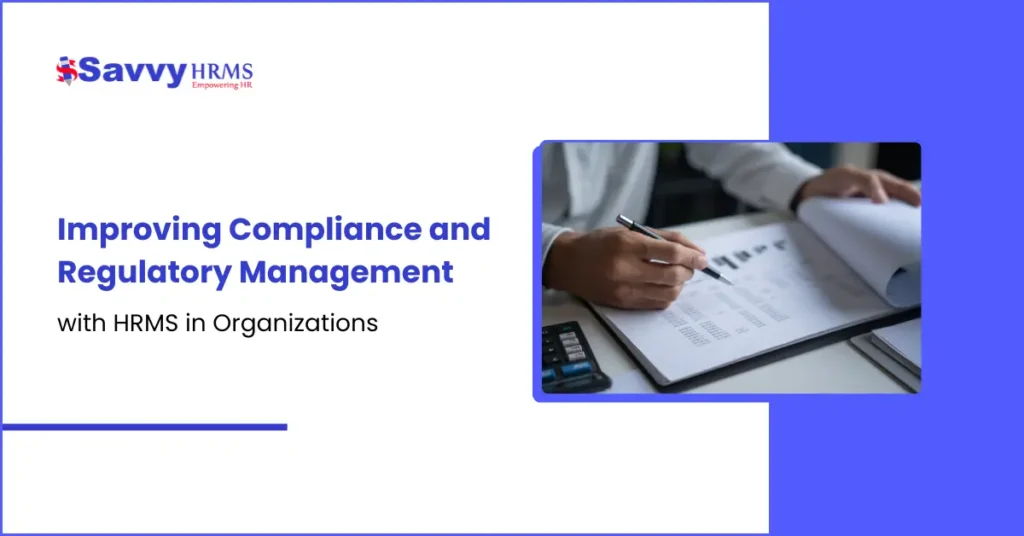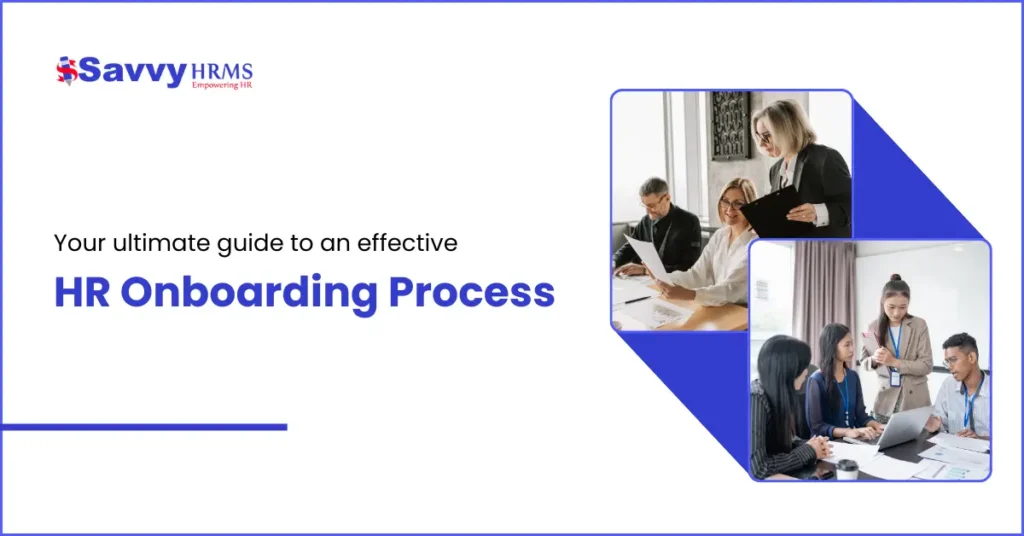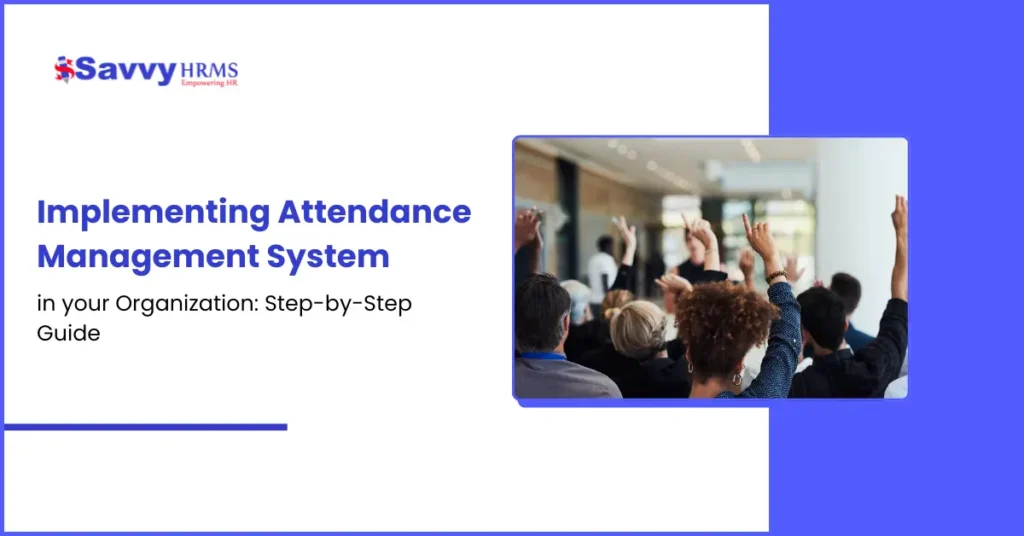When it comes to managing regulatory compliance, organizations face many difficulties across labor laws, tax regulations, and workplace safety standards. These rising requirements demand accuracy and timely implementation, creating manual compliance management both challenging and open to errors
When it becomes complicated for HR leaders to track deadlines, maintain updated records, and respond to new rules, HRMS solutions provide important support. By automating key compliance tasks and combining employee data, HRMS minimizes manual paperwork, reduces human errors, and ensures organizations stay aligned with statutory regulations.
When it is complex to maintain transparency, protect sensitive employee database, and stay audit-ready at any time, HRMS gives clear visibility and secure documentation. With simplified tracking of certifications, licenses, and policy compliance, HRMS integrates compliance into daily HR tasks, increasing organizational integrity and reducing risk.
Why Does Every Organization Depend on HRMS for Stronger Compliance Management?
Organizations depend on HRMS for compliance management, especially statutory compliance management, for three important reasons. First, labor laws and statutory regulations are being updated continuously, and it is difficult for the manual method to keep up with these changes. HRMS software is frequently auto-updated, which allows the employer to follow the law without the manual addition of processes or software corrections.
Second, HRMS solutions normally keep employee records, payroll, attendance, and leave all in one secure platform. This enables easier and simplified record-keeping, which reduces error and quickens access to required compliance documentation whenever the organization is required to prepare for the same. The presence of an audit log, consistent date stamps, and real-time reminders when deadlines or breaches occur ensures that employers do not miss any important deadlines or fail to comply with documentation.
Finally, possibly non-compliance with regulatory standards can result in some consequences, fines, and loss of reputation, among other reasons. HRMS platforms work to reduce human errors and incorrect mandatory calculations (e.g., deductions), and provide timely reports that boost audit suitability for internal and external audits. These processes provide management with confidence that risks of non-compliance are minimized and any compliance issues can be easily handled.
The Role of HRMS in Compliance and Regulatory Management
HRMS systems play an important role in enabling organizations to meet compliance requirements efficiently. Here are some key functions performed by HRMS in compliance and regulatory management:
1. Automating Statutory and Labor Law Compliance
Automating statutory and labor law compliance in HRMS plays an important role in empowering an organization’s overall statutory compliance management, which provides key benefits, including:
- Automatic calculation and deduction of PF, ESI, PT, and TDS as per updated laws.
- Timely generation of reports and filings to meet regulatory deadlines.
- Minimized manual human errors and administrative workload.
- Controlled storage of compliance data for easy access and audits.
- Continuous updates to give legal changes, ensuring uninterrupted compliance.
This automation simplifies complex statutory processes, minimizes risks of costly penalties, and saves the valuable time of HR leaders.
2. Ensuring Accurate Payroll Calculations and Mandatory Deductions
Confirming accurate payroll calculations and essential deductions is an important strength of HRMS, which:
- Automatically calculates salaries including minimum wages, overtime pay, taxes, and social security contributions.
- Updates deduction rates quickly when laws change, ensuring ongoing compliance.
- Produce payslips that meet legal requirements, minimizing payroll disturbances.
- Integrates attendance and leave management for precise salary distribution.
- Reduces manual errors and speeds up payroll processing.
- Gives transparency to employees through self-service portals to view their payroll information independently.
This automation protects organizations from financial and legal risks while enhancing payroll accuracy and efficiency.
3. Centralized Storage of Employee Records and Compliance Documents
Centralized storage of employee records and compliance documents in HRMS offers some advantages:
- Securely combine all employee information, like contracts, certifications, and licenses, in one digital platform.
- Enables quick recovery of documents during audits or compliance checks, preventing the risk of any document loss.
- Uses advanced search and metadata marking for fast access to some specific records.
- Protects sensitive information with role-based access controls and security.
- Supports remote access with cloud-based storage and ensures data safety through backups and data recovery.
This centralized process improves HR efficiency, data security, and regulatory compliance.
4. Real-Time Compliance Alerts and Deadline Notifications
Real-time compliance reminders and deadline notifications in HRMS help organizations stay always on top of regulatory requirements by:
- Automatically sending reminders to HR leaders and managers for upcoming tax filings, license renewals, and compliance deadlines.
- Providing notifications for health and safety training completions and other important tasks.
- Ease timely action to avoid missed deadlines and costly penalties.
- Supporting continuous audit preparedness with automated task tracking.
- Improving overall compliance management efficiency and minimizing manual follow-ups.
These features make sure that organizations never miss important compliance dates, maintaining legal compliance smoothly.
5. Simplifying Leave, Attendance, and Overtime Compliance
Simply leave, attendance, and overtime compliance through HRMS that offers these key benefits:
- Tracks employee attendance records, leave balances, and overtime pay correctly to align with labor laws.
- Maintains transparent records to minimize arguments related to working hours and leave adjustments.
- Automates leave requests, approvals, and precise calculations based on organizational policies.
- Prevents time theft and buddy punching with biometric and digital check-in systems.
- Integrates with payroll for accurate salary distributions, including overtime pay, ensuring legal compliance.
This ensures fair employee satisfaction, minimizes compliance risks, and improves HR leader operational efficiency.
6. Maintaining Data Security and Privacy as per Regulations
Managing data security and privacy in HRMS includes various advanced controls to protect sensitive employee data and align with data protection, such as GDPR. Some key aspects include:
- Automates compliance tasks to minimize human errors in payroll and filings.
- Keeps payroll correct and updated for legal changes, reducing miscommunications.
- Centralizes employee documents for quick and secure audit access.
- Sends real-time reminders to meet deadlines on filings, licenses, and training.
- Tracks leave, attendance, and overtime pay to ensure compliance and transparency.
- Secures sensitive employee data using encryption, access controls, and audit logs.
This simplifies legal compliance, secures employee data, and minimizes risks.
7. Supporting Internal Audits with Complete, Error-Free Data Trails
HRMS audit log gives a complete, error-free record of all HR transactions, supporting internal audits by:
- Ensuring data integrity by following every change with user and working hours details.
- Improving security through observing access and adjustments to sensitive data.
- Simplify compliance by maintaining thorough, available records for review.
- Increasing audit efficiency by simplifying confirmation and reducing inconsistency.
- Encouraging accountability by clearly showing who creates the changes and when.
This makes audit processes more dependable and helps organizations uncover issues early, improving overall HR compliance and governance.
8. Generating Compliance Reports for Regulators and Management
Key points for HRMS generating compliance reports:
- HRMS automates the foundation of statutory and internal reports, minimizing manual human effort.
- Create accurate, complete reports quickly for regulatory agencies and management.
- Supports multinational compliance with timely filing and onboarding reminders.
- Provides customizable, real-time dashboards for quick supervision and decision-making.
- Simplify audit readiness and reduce risks by maintaining organized, accessible records.
These features simplify compliance management and improve regulatory compliance.
Key Compliance Features Every HRMS Should Offer
- Auto-updating Compliance Rules: HRMS should stay aligned with developed labor laws and tax regulations automatically to ensure ongoing compliance.
- Payroll Automation with compulsory Deductions: Ensures accurate payroll processing aligned with legal deduction requirements.
- Document Management System: Secure digital storage for employee contracts, licenses, and compliance certificates.
- Automated Alerts and Notifications: Timely alerts for compliance deadlines and regulatory filings.
- Leave and Attendance Management: Transparent tracking to apply legal limits on working hours and leave permissions.
- Role-Based Data Security: Protects employee-sensitive information and complies with data privacy laws.
- Audit Logs: Maintains an informative history of all HR actions for audit preparedness.
- Compliance Reporting Tools: Simplifies the formation of regulatory and internal compliance reports effectively.
How HRMS Reduces Risks and Prevents Costly Penalties?
HRMS reduces the risk of compliance errors and prevents costly penalties by:
- Eliminates human errors in statutory calculations and record-keeping.
- Provides timely reminders to avoid missed compliance deadlines.
- Make sure correct payroll processing with the correct tax and benefit deductions.
- Centralizes documentation to support fast regulatory audits.
- Apply compliance to labor laws through an automated leave and attendance management system.
- Protects sensitive employee data with strong security features.
- Generates real-time compliance reports for active issue resolution.
Enhancing Transparency and Accountability with HRMS
With the right HRMS platform, organizations achieve greater transparency by building trust among employees for their record-keeping, compliance status, and payroll data. This visibility allows HR leaders, managers, and auditors to access correct and up-to-date information whenever needed, minimizing confusion and clashes. By automating workflows and approvals, HRMS has applicable contributors accountable for compliance activities, strengthening statutory compliance management, and reducing the risk of inconsistencies.
Moreover, employees have access to their personal information, payslips, and leave balances through self-service portals. This transparency boosts trust and encourages compliance from all levels within the organization, improving a culture of accountability and regulatory compliance.
Future of Compliance: Automation, Analytics, and AI in HRMS
- AI-powered automation will operate the next phase of compliance management by predicting risks through informative data analysis and identifying irregularities early.
- Reduced manual interference will simplify monitoring, reporting, and regulatory updates, allowing HR leaders to focus on strategic tasks.
- Advanced insights will give actionable analytics into labor cost trends, absenteeism, employee working patterns, and policy compliance.
- Predictive analytics will help HR teams outlook potential compliance errors and take preventive action.
- AI chatbots and virtual assistants will offer real-time regulatory guidance, helping employees to solve compliance-related queries instantly.
- Better global compliance alignment will be important as regulations become more complicated and interconnected across regions.
- HRMS integrated with AI and analytics will become essential for organizations targeting to maintain compliance efficiently, securely, and competitively.
Conclusion: The Role of HRMS in Regulatory Compliance
HRMS solutions are an important support for organizations looking to maintain strong compliance management, especially statutory compliance management in a developing regulatory landscape. By automating statutory tasks, combining sensitive employee data, and providing real-time monitoring and reporting, HRMS minimizes errors, improves transparency, and simplifies audits. These tools not only protect organizations from costly penalties but also boost a culture of accountability across all levels.
Selecting a complete HRMS adapted to meet your compliance needs can be transformative, ensuring your organization remains fast and legally compliant even as regulations change frequently.
To experience the full benefits of HR compliance automation, choose Savvy HRMS, an all-in-one solution especially designed to simplify compliance management, secure data, and empower your HR leaders with intelligent tools and real-time analytics. With Savvy HRMS, organizations can easily stay ahead of regulatory demands while focusing on organizational growth and employee engagement.



